No products in the cart.
Rupert Neve Shelford Channel Microphone Preamp
₹403990₹448500 (-10%)
- Rupert Neve Shelford Channel is Neve’s 80 Series channel module technology reached its pinnacle of development.
- A comprehensive channel strip that offers modern versatility while capturing the essence of classic fashions
- Transformer-gain mic preamp, input stage, and front-panel hi-Z direct input
- Among the classic inductors, the best EQ
- Outstanding Compressor for Diode-bridge
The Rupert Neve Channel Strip: The Final Version
After more than 50 years of development, Rupert Neve Designs’ Shelford Channel is the ultimate advancement of Mr. Neve’s well-known 80 Series channel module technology, updated and improved for the modern studio. Rupert’s most recent Class A transformer-gain mic preamp, the Shelford 5052’s legendary Inductor EQ, a powerful diode-bridge compressor, the seductive analog textures of variable Silk saturation, a cutting-edge dual-tap transformer output stage with enormous headroom, and twice the operating voltage of vintage designs are all included in the Shelford Channel. With its wide range of tonal possibilities and recall-friendly, precisely-detented controls, the Shelford Channel offers both the contemporary adaptability and authoritative sound of vintage Rupert Neve designs.
Microphone Preamp and transformer-gain stage
In the Shelford Channel, Rupert Neve debuts his first brand-new Class A, transformer-gain mic preamplifier in more than 40 years. This preamp is configured by Rupert with a direct-coupled transformer input; the bespoke transformer itself provides amplification. The Channel’s instantly identifiable sonics are largely due to its innovative input transformer, which is painstakingly integrated with the nearby Class A input amplifiers. The sound is powerful and creamy-smooth, has great isolation, and virtually no noise.
The front-panel hi-Z instrument input on the Shelford Channel is a discrete Class A field-effect transistor with transformer architecture, similar to the well regarded RNDI from Rupert Neve Designs. However, for gain, it feeds the new RN4012 input transformer straight into the mic preamp. With a significant low-end weight and incredibly smooth high frequencies, this design offers astounding clarity on hi-Z sources. You can also use the DI’s passive via output to power a bass or guitar amplifier.
- Mic-DI/Line: alternates between line input and microphone/direct injection input.
- GND Lift: disengages the chassis earth from the audio signal ground.
- Signal LED: red denotes impending input stage clipping, while green indicates signal present.
- Mic Gain: 12-way precision rotary; 6dB steps from 0dB to 66dB are controlled.
- Trim: This rotary switch allows you to continuously adjust the gain by +/-6dB. 48V: This switch activates the phantom power on the microphone input.
- Phase: flips the signal path’s polarity, illuminating when activated.
- HPF Freq: switches on a 12dB/octave highpass filter with a frequency range of 20Hz–250Hz.
The pinnacle of vintage inductor EQ
Rupert’s favorite bands from his vintage equalizer designs are contained in the 3-band, custom-tapped inductor circuit that makes up the Shelford Channel’s EQ section. The 1064, which is well-known for its rich, rich bass, serves as the main model for the low-frequency range. In contrast to the 1064, however, the Channel allows you to employ the LF band as a shelving or peaking filter, which adds punch, dimension, and control over your bottom end. Based on the esteemed 1073, the midrange band is ideal for bringing forward and enhancing vocals and other sounds in a mix. Additionally, its “Proportional Q” reaction makes it perfect for reducing the frequency of issues. The high-frequency band combines elements of both modern and vintage design in a hybrid configuration. It ought to be mentioned
- EQ In: activates all EQ frequency bands, with the exception of HPF
- LF: modifies the boost/cut level at the chosen low frequency by up to 15dB.
- Low Freq: Four-position rotary switch to choose between the center or corner frequency of the LF band
- LF Peak: chooses whether to peak in (in) or shelving (out) in LF.
- Mid Hi Q: chooses between a 3.5 (in) or 2 (out) mid-band resonance.
- Mid: modifies the boost or cut at a chosen midfrequency by up to 15dB.
- Mid Freq: The midband EQ stage’s center frequency is selected by a 6-position rotary switch.
- HF Peak: chooses the mode for HF shelving (out) or peaking (in).
- 8K/16K: chooses an HF band center or corner frequency of 8 kHz (out) or 16 kHz (in).
- HF: modifies boost or cut at a chosen high frequency by up to 15dB.
The Compressor Super Diode-bridge
The diode-bridge compressor/limiter, like the transformer-gain microphone preamp and inductor EQ on the Shelford Channel, is based on the topologies of vintage Neve designs, such the 2254. Yet, full-wave rectification and a plethora of other control capabilities elevate it above the first concepts. Rupert’s old-school diode-bridge compressors were highly regarded for their warm, punchy response, but their high noise, short headroom, and rigid attack-time controls slightly hindered their performance. With its current precision and versatility, the Shelford Channel’s Super Diode-bridge Compressor produces the attitude-packed, “in your face” sound of those classics, making it perfect for any source. There are stereo link and full side-chain features available.
- Side Chain Insert Jacks (back panel): to adjust compressor performance finely
- Comp In: activates the compressor-limiter portion of the channel.
- Sets the point at which the compressor “kicks in”
- Compression slope ratios range from 1.5:1 (light) to 8:1 (heavy).
- SC Insert: inserts sidechain into rear panel the compressor’s level-determining circuit is routed through a highpass filter by inserting jacks into the sidechain signal path HPF to S/C.
- Gain: used to add make-up gain to offset the level attenuation that compression has lost.
- Timing: A 6-position rotary switch modifies the compressor’s attack and release speeds.
- Link: connects many devices’ sidechain controls for ganged or stereo operation.
- Pre EQ: modifies the circuit chain’s compressor order
- Blend: for convenient parallel compression, combines the compressed and dry signal.
- Quick: accelerates both the attack and the chosen compressor time constant being released
Dual-tap transformer output
Much greater tonal variety is offered by the Shelford Channel’s output stage, which nonetheless delivers the distinctive sound of Rupert Neve’s iconic designs. The RN2042 square-core output transformer’s dual-tap output offers high- and low-headroom outputs without sacrificing functionality. By utilizing the higher voltage design of the Shelford, the high-headroom tap produces a clear sound even at high volumes without any non-linear output-stage coloring. In contrast, the low-headroom tap allows you to emphasize this non-linear harmonic content by driving the Channel across its whole voltage range without clipping most professional interfaces. This output allows you to reach the transformer’s sweet spot for drums, bass, guitars, and other instruments. This can breathe new life into a recorded performance in a way that other effects just can’t.
The Texture and Silk Regulators
With its output transformer’s Silk Red/Blue and Texture controls from the Portico II Series, the Shelford Channel packs a secret weapon that the classics never had: the ability to adjust the output stage’s harmonic content and tone. You can achieve delicious second- and third-order harmonic distortion (the good kind) and output transformer saturation by turning on these controls and adequately driving your output. This will give your tracks a juicy, rich thickness that sounds like 1073 on steroids, all without running the risk of overloading the output stage. While the Blue mode works off the low frequencies, the Silk Red mode highlights harmonic content created by the high frequencies of the source. The quantity of additional harmonic content is adjusted with the Texture slider.When you deactivate Silk, the output sounds crisp and contemporary while still having Rupert’s massive transformer sound signature.
Neve’s enchanted voice
The electronics designs created by audio icon Rupert Neve helped to define the golden age of analog. The crew who has worked on a Neve 8078 or one of its predecessors can vouch for the excellence of Neve’s Series 80 consoles as the benchmark for hand-wired analog mixing desks. For more than fifty years, Mr. Neve has been at the vanguard of audio-circuit innovation. His firm, Rupert Neve Designs, is still at the forefront today, producing state-of-the-art devices that sound amazing and thoughtfully tackle the problems of the digital age.
Features of the Shelford Channel designed by Rupert Neve:
- Dual-tap transformer output
- Silk and texture controls
- Phantom Preamp with Solid State Design Type Power: In agreement; EQ: three bands, custom-tapped inductor
- Compressor: Side chain diode bridge compressor for stereo connecting
Additional information
| Preamp Type | Solid State |
|---|---|
| Number of Channels | 1 |
| Phantom Power | Yes |
| Polarity Switch | Polarity Switch |
| EQ | 3-band EQ, custom-tapped inductor EQ |
| Compressor | Diode Bridge Compressor (side chain, stereo linking) |
| Other Processing | Red/Blue Harmonic Texture control |
| Analog Inputs | 1 x XLR (mic), 1 x XLR (line), 1 x 1/4" (Hi-Z) |
| Analog Outputs | 1 x XLR (line), 1 x XLR (-6dB out), 1 x 1/4" (thru) |
| Other I/O | 2 x 1/4" Side Chain (send, return), 2 x 1/4" (link) |
| Rack Spaces | 1U |
| Power Source | Standard IEC AC cable |
| Height | 1.75" |
| Depth | 10.5" |
| Width | 19" |

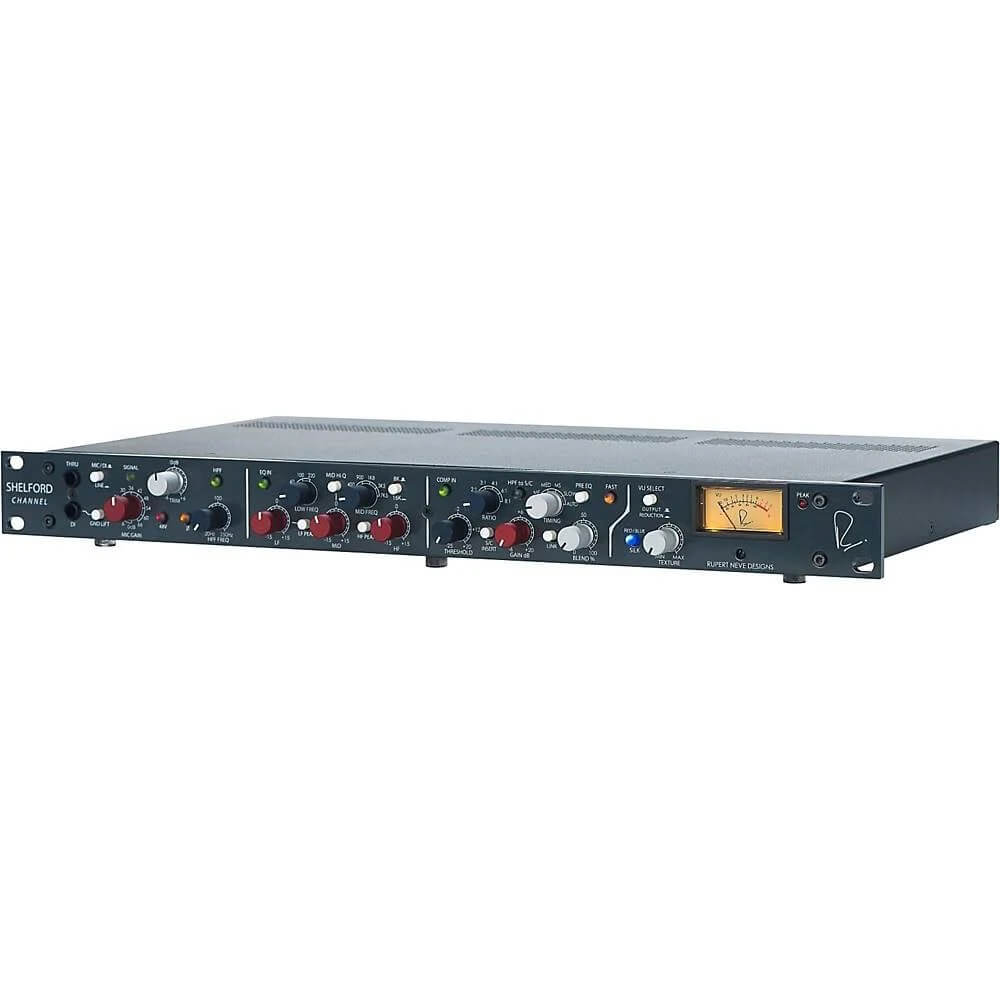
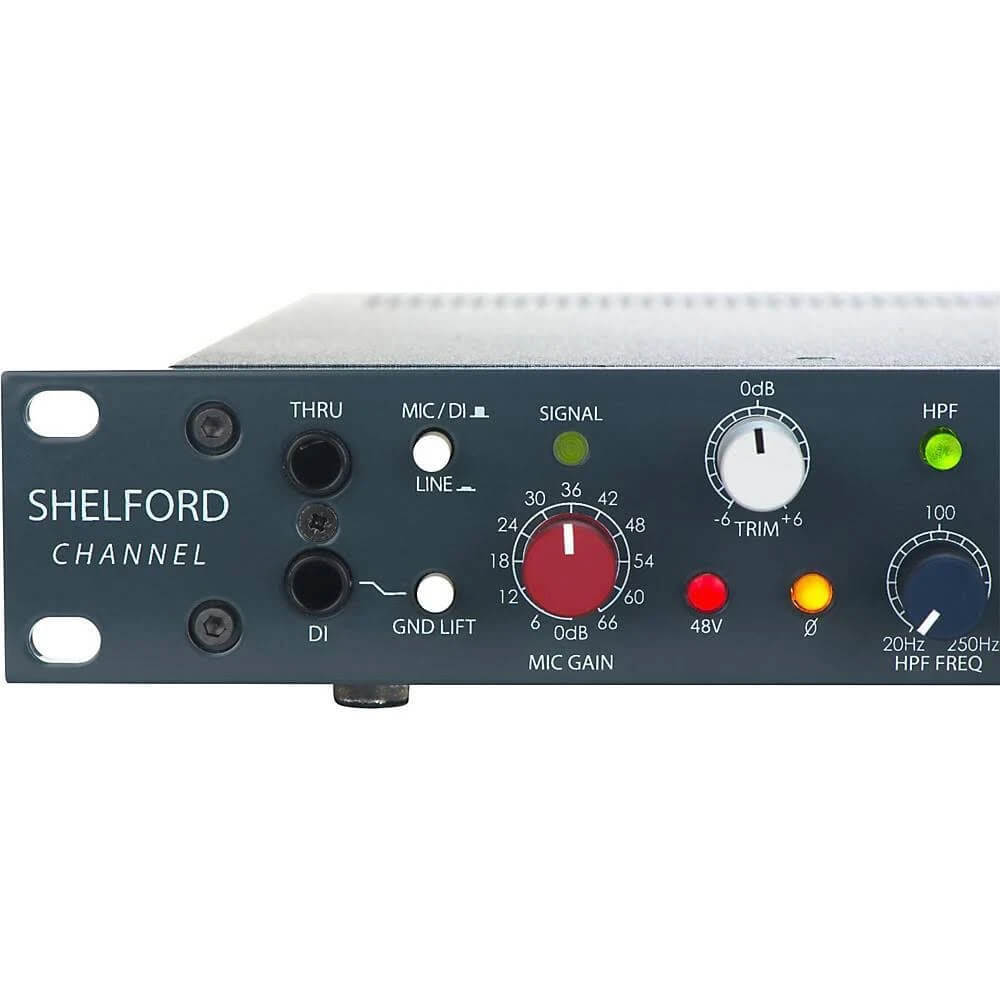
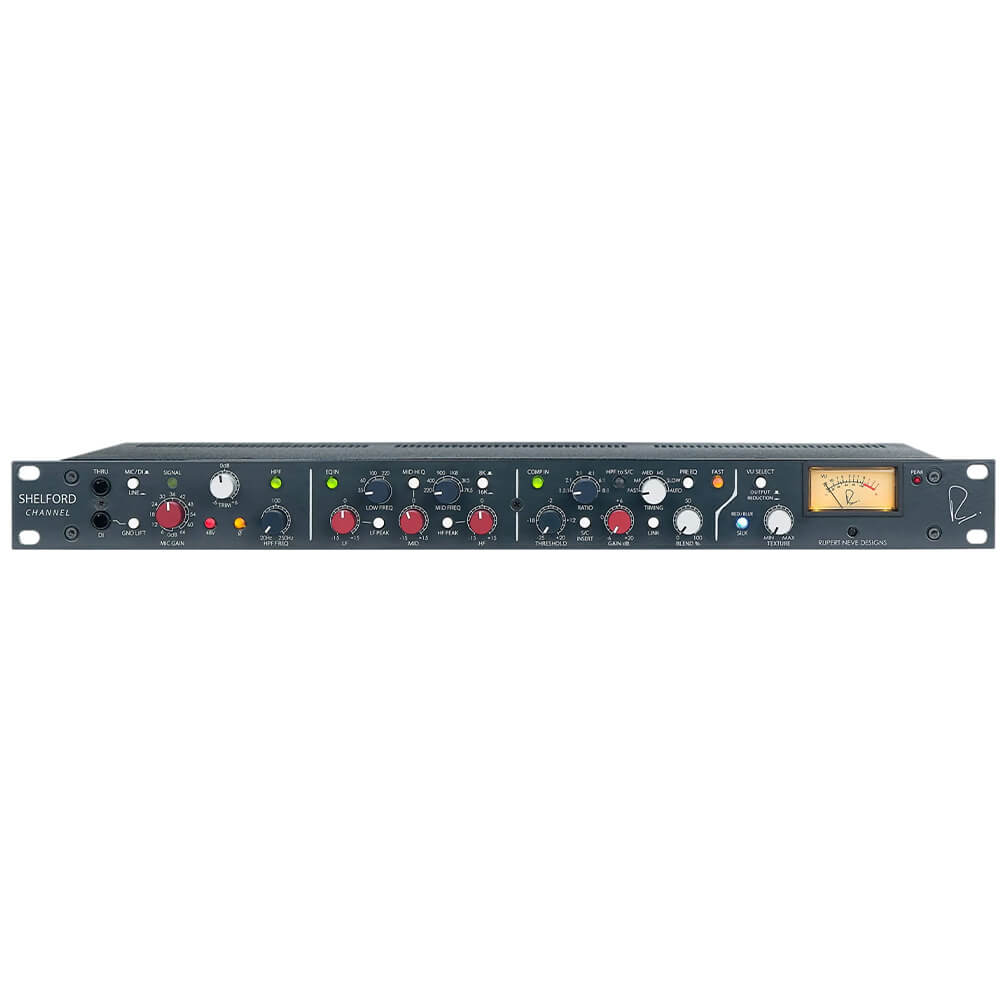
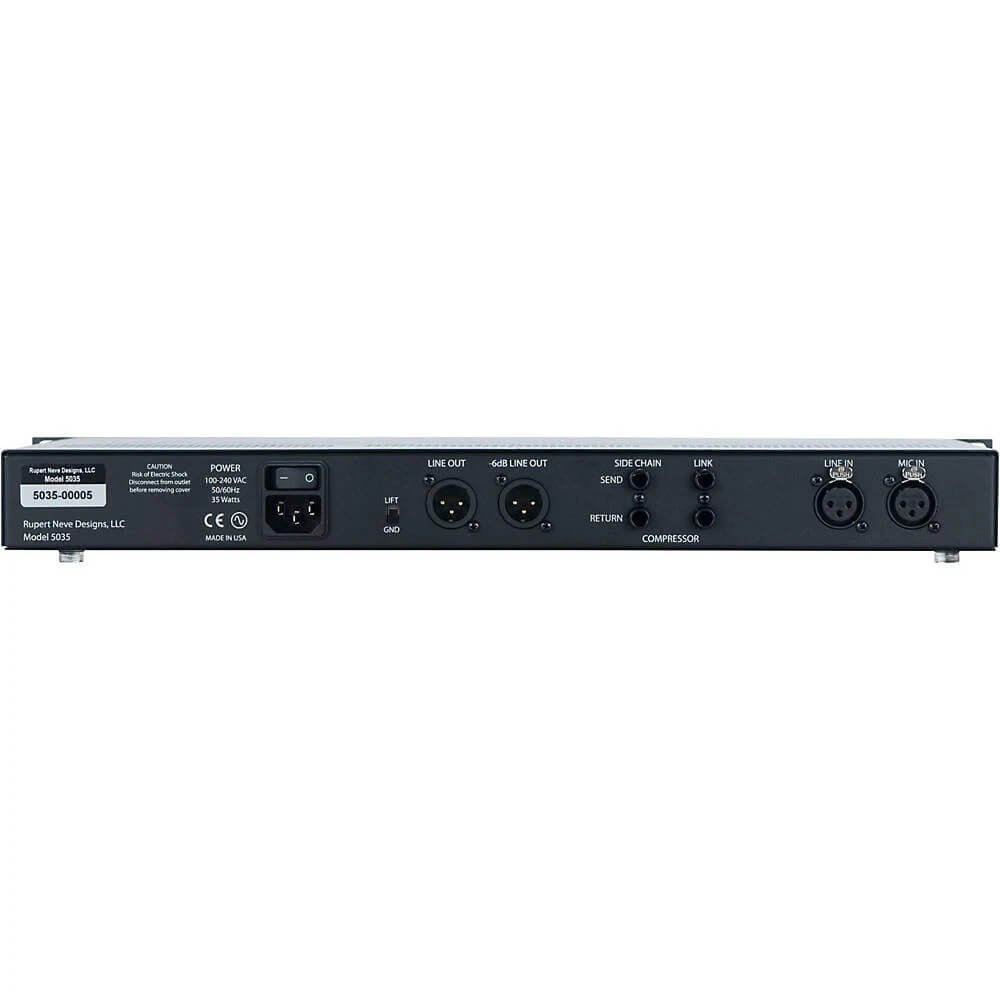
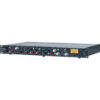
Reviews
There are no reviews yet.